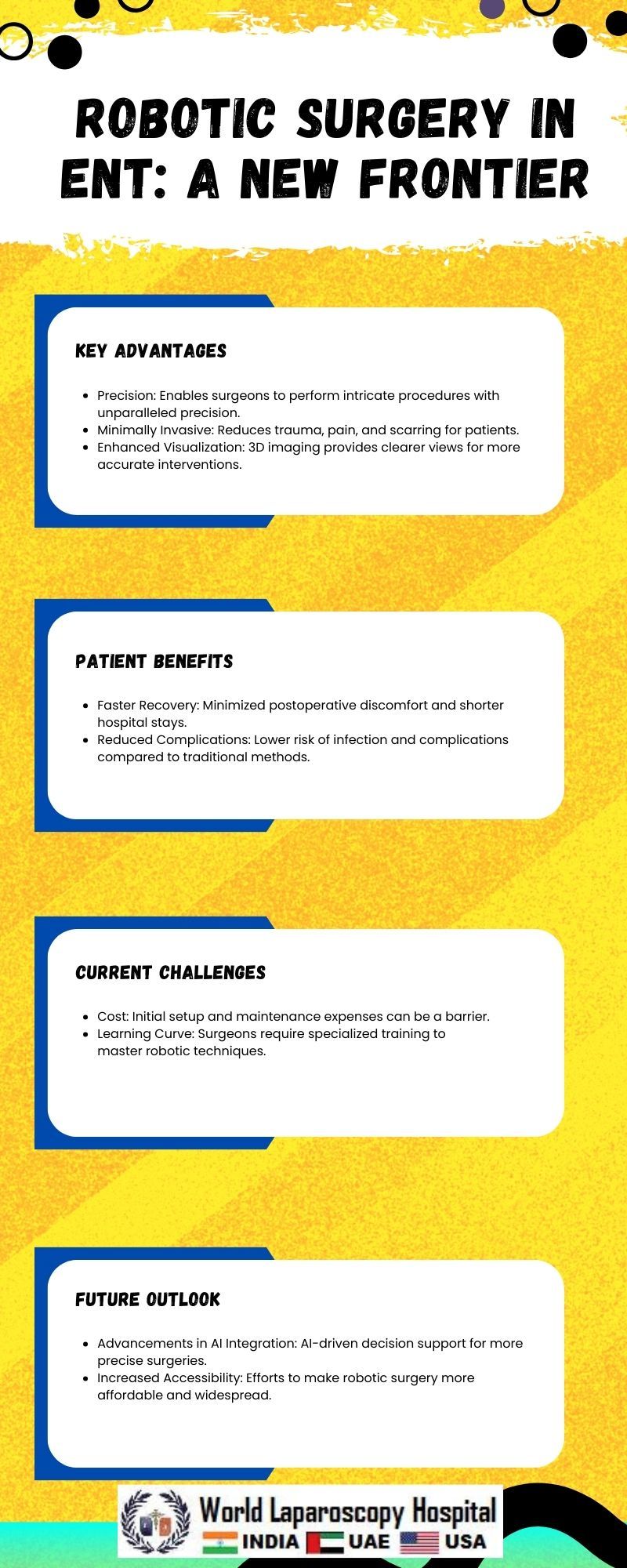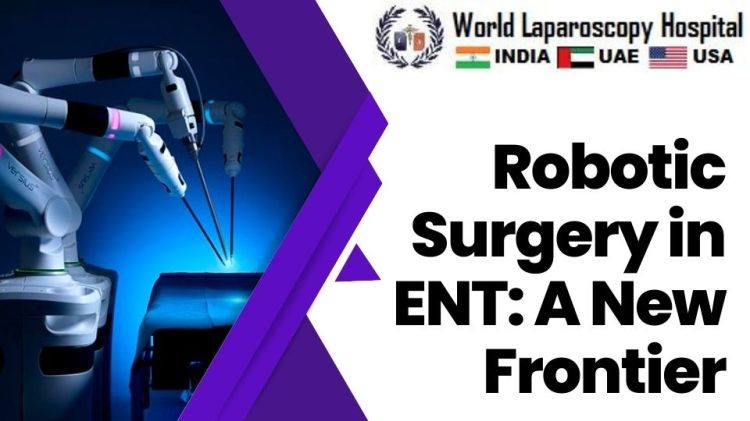Robotic Surgery in ENT: A New Frontier
Introduction
In recent years, the field of medicine has witnessed remarkable advancements, and one such groundbreaking innovation is robotic surgery in Ear, Nose, and Throat (ENT) procedures. The integration of robotic technology into the realm of ENT surgery has ushered in a new era of precision, efficiency, and patient care. This article explores the evolution of robotic surgery in ENT, its applications, benefits, challenges, and the transformative impact it has on the healthcare landscape.

The Evolution of Robotic Surgery in ENT
The concept of using robots in surgery originated in the 1980s, and since then, technological strides have paved the way for the integration of robotic systems into various medical disciplines. In the field of ENT, the transition to robotic surgery began in the early 2000s, with the da Vinci Surgical System emerging as a pioneer in the domain.
The da Vinci Surgical System, developed by Intuitive Surgical, Inc., represents a sophisticated robotic platform designed to facilitate minimally invasive surgery. Initially utilized in urological and gynecological procedures, its application expanded to encompass ENT surgeries due to its unparalleled precision and maneuverability. This robotic system consists of a console from which the surgeon controls the robotic arms equipped with surgical instruments.
Applications of Robotic Surgery in ENT
Head and Neck Cancer Surgery:
Robotic surgery has become instrumental in treating head and neck cancers, allowing surgeons to access intricate areas with enhanced precision. The precise movements of the robotic arms enable the removal of tumors while preserving surrounding healthy tissues, minimizing postoperative complications.
Thyroid and Parathyroid Surgery:
Thyroid and parathyroid surgeries often involve delicate structures in the neck. The use of robotic systems provides surgeons with a three-dimensional view and improved dexterity, enabling meticulous procedures with smaller incisions, reduced scarring, and quicker recovery times.
Tonsillectomies and Adenoidectomies:
Pediatric ENT surgeries, such as tonsillectomies and adenoidectomies, have also benefited from robotic assistance. The precision of the robotic instruments ensures accurate removal of tonsils and adenoids, reducing postoperative pain and promoting a faster recovery in children.
Sinus Surgery:
Chronic sinus conditions can be challenging to treat with traditional methods. Robotic surgery aids in sinus procedures by providing a magnified view of the nasal anatomy and facilitating precise interventions. This approach enhances the outcomes for patients suffering from chronic sinusitis.
Sleep Apnea Surgery:
Robotic surgery is increasingly employed in addressing sleep apnea, a common ENT-related condition. Surgeons can navigate the complex anatomy of the upper airway with greater accuracy, offering tailored solutions to alleviate obstructive sleep apnea and improve patients' quality of life.
Benefits of Robotic Surgery in ENT
Precision and Enhanced Visualization:
Robotic systems offer surgeons a three-dimensional, high-definition view of the surgical site, allowing for unparalleled precision and enhanced visualization. This level of detail is particularly crucial in ENT procedures where delicate structures are involved.
Minimally Invasive Approach:
The minimally invasive nature of robotic surgery is a significant advantage in ENT procedures. Smaller incisions lead to reduced scarring, less postoperative pain, and quicker recovery times for patients.
Improved Dexterity:
The robotic arms used in surgery provide a greater range of motion and dexterity compared to human hands alone. This is particularly beneficial in ENT surgeries, where the precision of movements is crucial to avoid damage to sensitive structures.
Quicker Recovery and Shorter Hospital Stays:
Patients undergoing robotic ENT surgery often experience shorter hospital stays and quicker recovery periods compared to traditional open surgeries. This contributes to a faster return to normal activities and a reduced overall impact on the patient's lifestyle.
Reduced Blood Loss:
The precision of robotic instruments contributes to reduced blood loss during surgery. This is a critical factor in ENT procedures, where minimizing blood loss is essential to prevent complications and facilitate a smoother recovery.
Challenges and Considerations
While robotic surgery in ENT has shown tremendous promise, it is not without challenges and considerations:
Cost:
The initial cost of acquiring and maintaining robotic surgical systems is significant. This can pose a financial challenge for healthcare institutions, potentially limiting widespread access to this advanced technology.
Training and Learning Curve:
Surgeons require specialized training to operate robotic systems effectively. The learning curve for mastering these technologies may deter some healthcare professionals from adopting robotic surgery in their practice.
Limited Haptic Feedback:
One limitation of robotic surgery is the lack of direct tactile feedback for surgeons. Unlike traditional open surgery, where the surgeon can feel the tissues directly, robotic systems provide limited haptic feedback. This requires surgeons to rely on visual and auditory cues, necessitating a higher level of skill and concentration.
Equipment Size and Setup:
The physical size of robotic systems and the complexity of setup may pose logistical challenges in some healthcare settings. Operating rooms need to be adequately equipped to accommodate robotic systems, potentially requiring infrastructure upgrades.
Patient Selection:
Not all patients may be suitable candidates for robotic surgery. Factors such as anatomy, previous surgeries, and overall health must be considered when determining the appropriateness of robotic interventions.
The Future of Robotic Surgery in ENT
As technology continues to advance, the future of robotic surgery in ENT holds exciting possibilities. Ongoing research and development aim to address current challenges and expand the applications of robotic systems in ENT procedures.
Artificial Intelligence Integration:
The integration of artificial intelligence (AI) into robotic surgical systems is an area of active exploration. AI algorithms could enhance surgical precision, assist in decision-making, and optimize postoperative outcomes.
Remote Surgery and Telemedicine:
Robotic surgery opens the door to remote surgical procedures, facilitated by the use of telemedicine. Surgeons could potentially perform ENT surgeries on patients located in different geographical locations, expanding access to specialized care.
Miniaturization of Robotic Systems:
Advances in miniaturization could lead to the development of smaller, more portable robotic systems. This could make robotic surgery more accessible in a broader range of healthcare settings, including ambulatory surgical centers and smaller hospitals.
Training Simulators:
Improved training simulators for robotic surgery may help address the learning curve associated with these technologies. Simulators can provide a realistic environment for surgeons to practice and refine their skills before performing actual procedures.
Cost Reduction Strategies:
Efforts to reduce the overall cost of robotic surgery systems and associated equipment are underway. This could make the technology more economically viable for a wider range of healthcare institutions, ultimately benefiting a larger patient population.
Conclusion
Robotic surgery in Ear, Nose, and Throat procedures represents a transformative frontier in healthcare. The precision, minimally invasive approach, and enhanced visualization offered by robotic systems have the potential to revolutionize the way ENT surgeries are performed. While challenges exist, ongoing research and technological advancements are paving the way for a future where robotic surgery becomes more accessible, cost-effective, and seamlessly integrated into routine medical practice. As the journey continues, the collaboration between medical professionals, engineers, and researchers holds the key to unlocking the full potential of robotic surgery in ENT and improving patient outcomes on a global scale.
